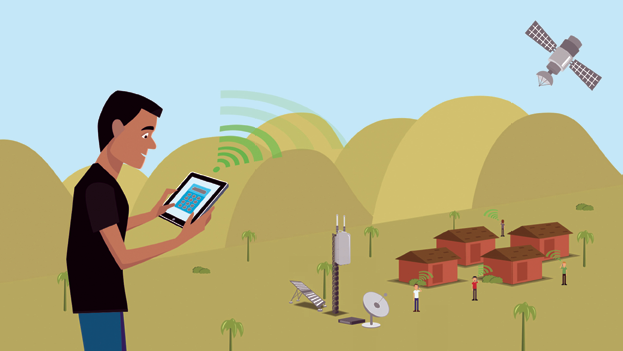There’s an untapped market niche that mobile operators have not been paying enough attention to: the millions of currently unserved, potential rural customers worldwide, who clamor for cellular voice and data broadband connectivity in areas with no communication infrastructure availability.

Several drivers converge that can help boost this market:
1. New, small cell technologies enable a viable business case.
The base station has evolved from traditional, bulky and costly macro cells, which require very high capital expenditure (CAPEX) with costly towers, large diesel generators and indoor and outdoor equipment. These structures also require never-ending operating expenditure (OPEX) of high fuel costs and logistics. These costs cannot be justified when connecting a village of a few thousand people. Low-cost, outdoor small cells, make rural connectivity a reality.
2. Digital-divide regulations and funding (USO/USF).
Governments offer incentives to deliver affordable, accessible Internet connectivity to rural areas, in attempts to boost educational and economic opportunities. These incentives are offered by governments worldwide, and represent an opportunity—and challenge—to deliver not only Internet access, but quality, broadband access to rural areas. This trend is now becoming more prevalent in Africa, following the footsteps of adoption in Latin America.
3. High Throughput Satellites (HTS).
This up-and-coming technology uses multi-spot beams to optimize bandwidth, enabling reuse of the frequency band across coverage areas. This approach substantially increases satellite broadband capacity while reducing bandwidth costs (OPEX). HTS adoption further supports a viable business case for expanding into rural areas via a satellite backhaul.
The Small Cell Over Satellite Solution
The Small Cell
Small cell technology comprises low-powered 2G/3G/LTE cellular radio access nodes. It was developed to overcome macro cells’ difficulties in providing dense urban areas with high data rates in non-line of sight and within buildings.
Small cells overcome this issue and provide better coverage and capacity for ever-growing, bandwidth-hungry content that is streamed over cellular networks. This technology is ideal for smaller rural communities with 16 to 32 simultaneous calls over an area of up to about a 3 kilometer radius.
This technology solves the issue of placing macro cells in deep rural areas, which is pure overkill: and certainly, not a business case, since ARPU in these locations is low, and traffic is not very high.
Small cells serve as an excellent communications media, since they were designed originally for data handling. Gilat offers the CellEdge small cell over satellite solution, featuring the latest version of 3G – HSPA+, with data rates of up to 21Mbps in the downlink and 5Mbps in the uplink.

The equipment is low cost, compared to macro cells, and is easy to install and to maintain. Because small cells “live” outdoors, they require no ground shelter, and they are long-lasting, requiring no maintenance.
However, perhaps one of the most compelling factors favoring small cells is their ability to be operated by solar power. That’s a big contrast to the expense and effort involved in diesel generator refueling, used in macro cell deployments.
The Backhaul
The small cell on its own is not a full solution. The next challenge to overcome is: which backhauling technology is most appropriate for coupling with the small cell?
The two common solutions include:
1. Traditional, copper or fiber lines.
Although this solution is widespread, it is mainly used in urban areas. It is not economically viable for rural areas, because it requires infrastructure to distant, often challenging terrain.
2. Microwave transmission.
This technology’s higher frequencies enable transmission of large quantities of data. However, microwave communications require line of sight and flat terrain to be cost effective, not usually found in remote, mountainous regions.
Obviously, neither of these prevalent technologies is the answer for rural connectivity.
Satellite backhauling is becoming more and more the backhaul of choice, and often the only solution for rural areas. Various technological developments, especially in Ku- and Ka-bands, are reducing satellite communication costs, making satellite backhaul an affordable alternative.
Today, we are also seeing higher frequency Ku- and Ka-band solutions that can address the rain fade consideration with sophisticated adaptive coding and modulation techniques. This advancement reduces CAPEX, because smaller lower cost antennas are sufficient for broadband communication.
The reduced costs are further supported with TDMA modems, instead of the traditional, dedicated, and more expensive SCPC links. On-demand bandwidth allocation is better suited to low traffic rural communities where efficient allocation of the satellite resources can be provided, as needed.
An Integrated Way to Connect The Unconnected
With all these great technologies, providers are still challenged: How do they connect the dots? They require a tightly integrated solution, preferably from one vendor as one point of contact, who can help them deliver cost-effective 2G/3G/LTE cellular services to unconnected communities quickly and economically.
This single solution ought to be able to support high capacity, wide coverage and high transmission rates, while saving substantially on bandwidth costs and supporting the use of exceptionally low-cost solar power at off-grid locations.

To deliver a quality broadband experience for cellular voice and data, tight integration between the small cell and the backhaul must be implemented to ensure that resource allocation is efficient enough to support the payload required by the cell, with minimum protocol overheads.
Gilat, experts in satellite backhaul to rural areas with more than 2,000 cellular backhaul installations worldwide, offers the turnkey, CellEdge high-performance small cell over satellite solution, which features optimization of voice and data compression techniques, in addition to high bandwidth efficiency algorithms. This technology minimizes satellite space segment overhead, combined with satellite bandwidth allocation on demand, reducing satellite OPEX by as much as 80 percent.
Additionally, the integrated CellEdge solution ensures an enhanced user experience, using TCP and HTTP acceleration to overcome the inherent satellite delay.
To see how it works, please visit http://www.gilat.com/Small-Cell
About the author
Doreet Oren (doreeto@gilat.com) is Director of Product Marketing for Gilat Satellite Networks. In this role, Oren works closely with the Commercial and Defense divisions to define product positioning, messaging and go-to-market strategies and is responsible for market research and analyst relations.
Oren has more than 20 years of industry experience, and has held management positions in R&D, product management and product marketing for international high-tech companies. In this capacity, she contributed to next-generation product definition and was responsible for delivering the company’s vision to the media and analyst community. Oren has published thought leadership articles in renowned international journals, and has spoken at numerous industry conferences worldwide. Oren received a BSc in Computer Science from George Washington University.

